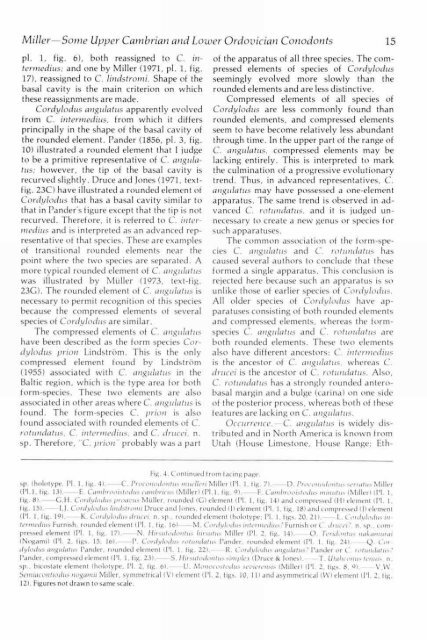View - KU ScholarWorks - University of Kansas
View - KU ScholarWorks - University of Kansas
View - KU ScholarWorks - University of Kansas
You also want an ePaper? Increase the reach of your titles
YUMPU automatically turns print PDFs into web optimized ePapers that Google loves.
Miller—Some Upper Cambrian and Lower Ordovician Conodonts 15<br />
pl. 1, fig. 6), both reassigned to C. intermedius;<br />
and one by Miller (1971, pl. 1, fig.<br />
17), reassigned to C. lindstromi. Shape <strong>of</strong> the<br />
basal cavity is the main criterion on which<br />
these reassignments are made.<br />
Cordylodus angulattis apparently evolved<br />
from C. intermedius, from which it differs<br />
principally in the shape <strong>of</strong> the basal cavity <strong>of</strong><br />
the rounded element. Pander (1856, pl. 3, fig.<br />
10) illustrated a rounded element that I judge<br />
to be a primitive representative <strong>of</strong> C. angulatus;<br />
however, the tip <strong>of</strong> the basal cavity is<br />
recurved slightly. Druce and Jones (1971, tex t-<br />
f ig. 23C) have illustrated a rounded element <strong>of</strong><br />
Cordylodus that has a basal cavity similar to<br />
that in Pander's figure except that the tip is not<br />
recurved. Therefore, it is referred to C. interwedius<br />
and is interpreted as an advanced representative<br />
<strong>of</strong> that species. These are examples<br />
<strong>of</strong> transitional rounded elements near the<br />
point where the two species are separated. A<br />
more typical rounded element <strong>of</strong> C. angulatus<br />
was illustrated by Muller (1973, text-fig.<br />
23G). The rounded element <strong>of</strong> C. angulatus is<br />
necessary to permit recognition <strong>of</strong> this species<br />
because the compressed elements <strong>of</strong> several<br />
species <strong>of</strong> Cordy/ochts are similar.<br />
The compressed elements <strong>of</strong> C. angulatus<br />
have been described as the form species Cordylodus<br />
prion Lindstriim. This is the only<br />
compressed element found by LindstrOm<br />
(1955) associated with C. angulatus in the<br />
Baltic region, which is the type area for both<br />
form-species. These two elements are also<br />
associated in other areas where C. angulatus is<br />
found. The form-species C. prion is also<br />
found associated with rounded elements <strong>of</strong> C.<br />
rotundatus, C. intermedius, and C. tirucei, n.<br />
sp. Therefore, -C. prion - probably was a part<br />
<strong>of</strong> the apparatus <strong>of</strong> all three species. The compressed<br />
elements <strong>of</strong> species <strong>of</strong> Cordy/ocitts<br />
seemingly evolved more slowly than the<br />
rounded elements and are less distinctive.<br />
Compressed elements <strong>of</strong> all species <strong>of</strong><br />
Cordylodus are less commonly found than<br />
rounded elements, and compressed elements<br />
seem to have become relatively less abundant<br />
through time. In the upper part <strong>of</strong> the range <strong>of</strong><br />
C. angulatus, compressed elements may be<br />
lacking entirely. This is interpreted to mark<br />
the culmination <strong>of</strong> a progressive evolutionary<br />
trend. Thus, in advanced representatives, C.<br />
angulatus may have possessed a one-element<br />
apparatus. The same trend is observed in advanced<br />
C. rotundatus, and it is judged unnecessary<br />
to create a new genus or species for<br />
such apparatuses.<br />
The common association <strong>of</strong> the form-species<br />
C. angulatus and C. rotimiiiitti.,-; has<br />
caused several authors to conclude that these<br />
formed a single apparatus. This conclusion is<br />
rejected here because such an apparatus is so<br />
unlike those <strong>of</strong> earlier species <strong>of</strong> Conlylocitts.<br />
All older species <strong>of</strong> Cordylodus have apparatuses<br />
consisting <strong>of</strong> both rounded elements<br />
and compressed elements, whereas the formspecies<br />
C. angulatus and C. rotundatus are<br />
both rounded elements. These two elements<br />
also have different ancestors: C. intermedius<br />
is the ancestor <strong>of</strong> C. angulatus, whereas C.<br />
drucei is the ancestor <strong>of</strong> C. rotunda tus. Also,<br />
C. rotundatus has a strongly rounded anterobasal<br />
margin and a bulge (caria) on one side<br />
<strong>of</strong> the posterior process, whereas both <strong>of</strong> these<br />
features are lacking on C. angulatus.<br />
Occurrence. —C. angulatus is widely distributed<br />
and in North America is known from<br />
Utah (House Limestone, House Range; Eth-<br />
Fig. 4. Continued from facing page.<br />
sp. (holotype, Pl. 1, fig. 4). C. Procotiodwitits mitelleri Miller (1'1. 1, fig. 7). D. Procottotiotttits serratits Miller<br />
(P1.1, fig. 13). E. Cambrooistodus cambricu.s (Miller) (Pi. 1, fig. 9). F. Cambrooistodits mituttlis (Miller) (1'1. I,<br />
fig. 81.—G,H. Cordylodus proavus Iler, rounded (G) element (Pl. 1, fig. 14) and compressed (F1) element (Pl.<br />
fig. 15). 1,J. Cordylodus lindstromi Druce and Jones, rounded (1) element (Pl. 1, fig. 18) and compressed (1) element<br />
(1'1. 1, fig. 19). K. Cordylodus drucei, n. sp., rounded element (holotype; l'1. 1, figs. 20, 211.--L. Cordylodus<br />
tertnedius Furnish, rounded element (Pl. 1, fig. 16) M. Cordylotius termeditis ' Furnish or C. n. sp., compressed<br />
element (Pl. 1, fig. 17). N. Hirsmodontus larsutus Miller (PI. 2, fig. 14). 0. To -Om/tits nakamurai<br />
(Nogami) (Pl. 2, figs. 15, 16). P. Cordylocius rotundatus Pander, rounded element (Pl. 1, fig. 24). Q. Cortiylotitts<br />
angulatus Pander, rounded element (Pl. 1, fig. 22). R. Cordylodus angulatus:' Pander or C. rotiottiatits?<br />
Pander, compressed element (Pl. 1, fig. 23). S. Hirsutodoutus simpleA (Druce tones). T. Litahconus tenuis, n.<br />
sp., bicostate element (holotype. Pl. 2, fig. 6). Ii. Monocostodus sevierensis (Miller) (11. 2, figs. 8, 9). V.W.<br />
Semiacoutiodus nogamii Miller, symmetrical (V) element (PI. 2, figs. 10, 11) and asymmetrical (W) element (Pl. 2, fig.<br />
12). Figures not drawn to same scale.
















